Rooftop greenhouses represent the pinnacle of urban agriculture innovation, transforming unused building spaces into productive growing environments. These elevated growing systems combine sustainable design with cutting-edge technology to create year-round cultivation spaces in densely populated areas. Modern rooftop greenhouses incorporate automated climate control, renewable energy systems, and efficient water management to maximize productivity while minimizing environmental impact. From compact residential installations to large-scale commercial operations, these structures offer solutions for food security, educational opportunities, and community building. Whether implementing hydroponic systems, solar-powered ventilation, or integrated aquaponics, rooftop greenhouses provide endless possibilities for sustainable urban farming and environmental stewardship.
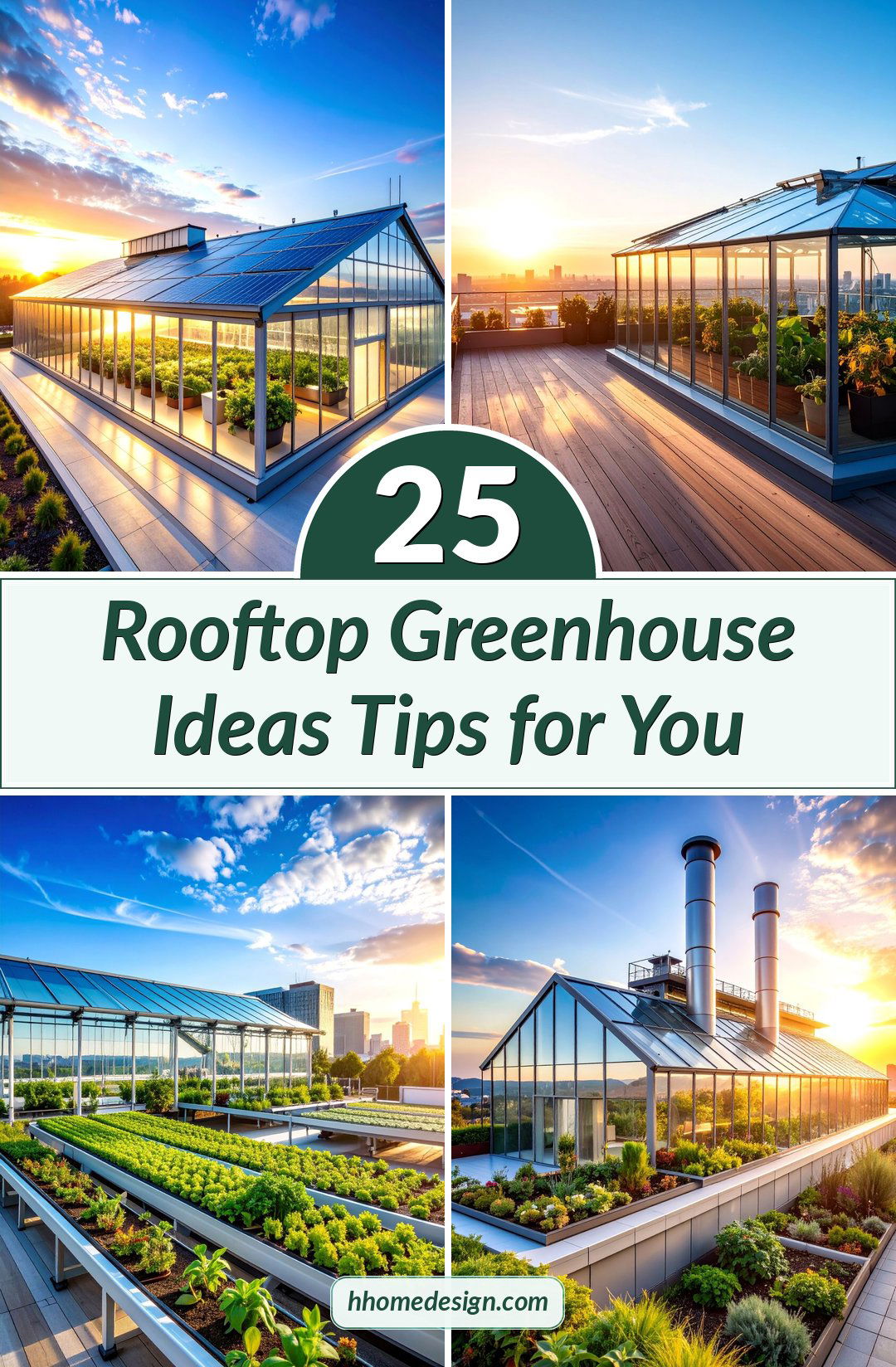
1. Solar-Powered Hydroponic Rooftop Greenhouse
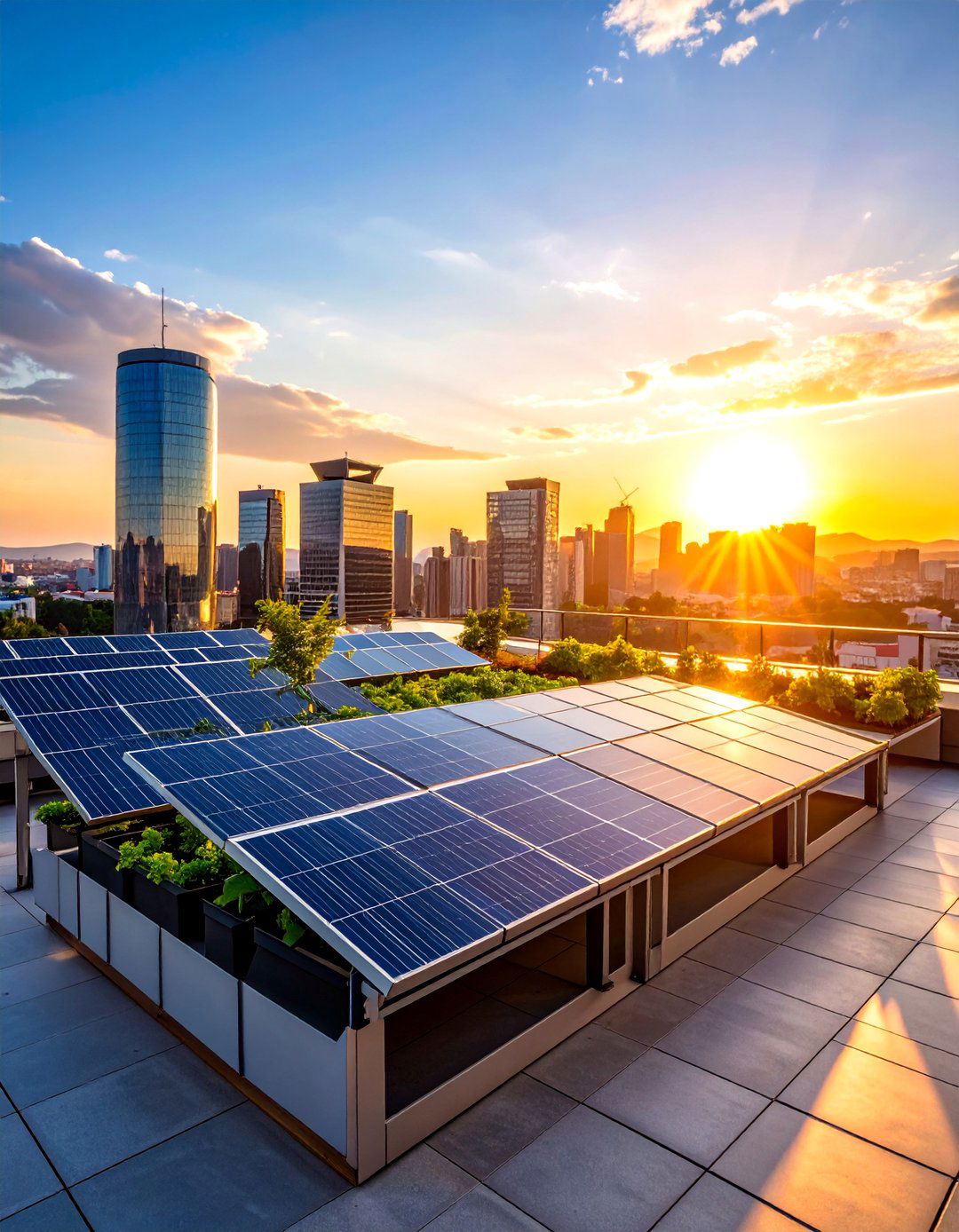
The solar-powered hydroponic rooftop greenhouse combines renewable energy with soil-free growing technology to create a sustainable urban farming solution. This design features integrated photovoltaic panels that power automated nutrient delivery systems, climate control equipment, and LED grow lights for year-round production. The structure utilizes lightweight aluminum framing with polycarbonate glazing to minimize roof load while maximizing light transmission. Advanced hydroponic systems include deep water culture beds, nutrient film technique channels, and vertical growing towers that optimize space utilization. Automated pH and nutrient monitoring ensures consistent plant health, while smart irrigation systems reduce water consumption by up to sixty percent compared to traditional farming methods. This greenhouse design produces fresh vegetables and herbs continuously while generating surplus renewable energy for building operations.
2. Glass Gothic Arch Commercial Rooftop Greenhouse
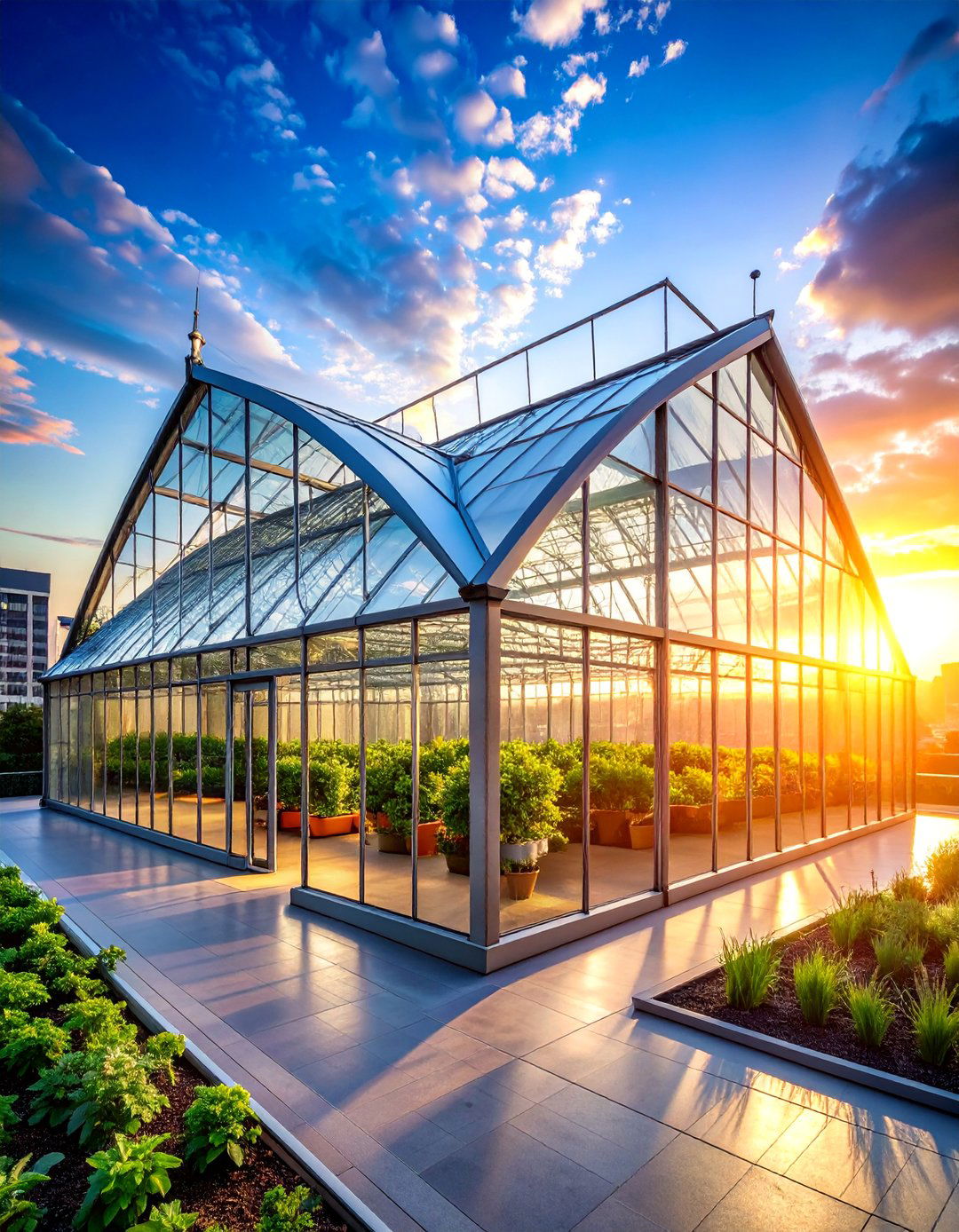
The glass gothic arch commercial rooftop greenhouse features elegant curved glass panels arranged in a pointed arch design that maximizes headroom and light distribution. This premium structure uses tempered glass glazing mounted on galvanized steel framing to create a durable, weather-resistant growing environment suitable for high-value crops. The gothic arch design efficiently sheds snow and rain while providing excellent structural strength against wind loads. Climate control systems include automated ventilation, heating, and cooling to maintain optimal growing conditions year-round. The spacious interior accommodates commercial-scale production equipment, packaging areas, and visitor walkways for agritourism operations. This design is ideal for restaurants, hotels, and urban farms seeking to produce premium herbs, microgreens, and specialty vegetables while creating an architectural focal point that enhances building aesthetics.
3. Polycarbonate Quonset Hydroponic Rooftop Greenhouse

The polycarbonate quonset hydroponic rooftop greenhouse combines cost-effective construction with efficient growing systems using a curved hoop design. This lightweight structure features twin-wall polycarbonate panels that provide excellent insulation while maintaining optimal light transmission for plant growth. The semi-circular design minimizes wind resistance and maximizes internal growing space with efficient use of materials. Hydroponic systems include NFT channels and ebb-and-flow tables that produce leafy greens, herbs, and strawberries year-round. Passive ventilation through roll-up sides and ridge vents maintains proper air circulation without electrical costs. This greenhouse design offers excellent value for urban farmers, schools, and community organizations seeking affordable rooftop agriculture solutions. The modular construction allows for easy expansion and relocation, making it perfect for temporary installations or growing operations that need flexibility.
4. Automated Aquaponics Rooftop Greenhouse Complex
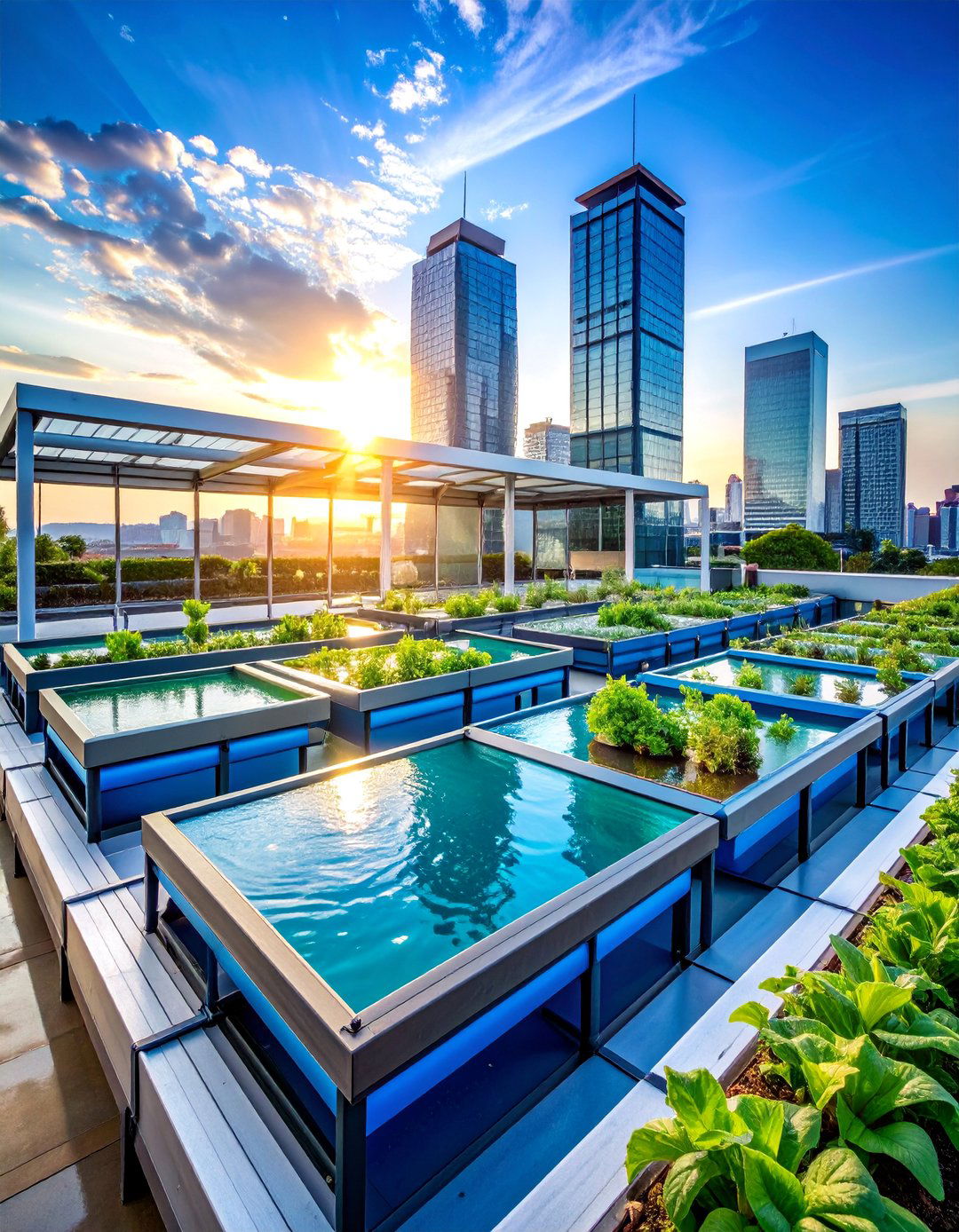
The automated aquaponics rooftop greenhouse complex integrates fish cultivation with hydroponic plant production in a closed-loop ecosystem. This innovative design features insulated grow beds, fish tanks, and biofilter systems that create a symbiotic relationship between aquatic animals and plants. Advanced automation controls water circulation, feeding schedules, and environmental conditions through IoT sensors and smartphone applications. The structure includes separate zones for fish production, plant cultivation, and harvest processing to optimize workflow efficiency. Climate control systems maintain optimal temperatures for both fish and plants while solar panels provide renewable energy for pumps, aerators, and lighting systems. This comprehensive design produces fresh fish, vegetables, and herbs while recycling nutrients and minimizing water waste, making it ideal for urban food production and educational demonstrations of sustainable agriculture principles.
5. Slant-Roof Solar Rooftop Greenhouse
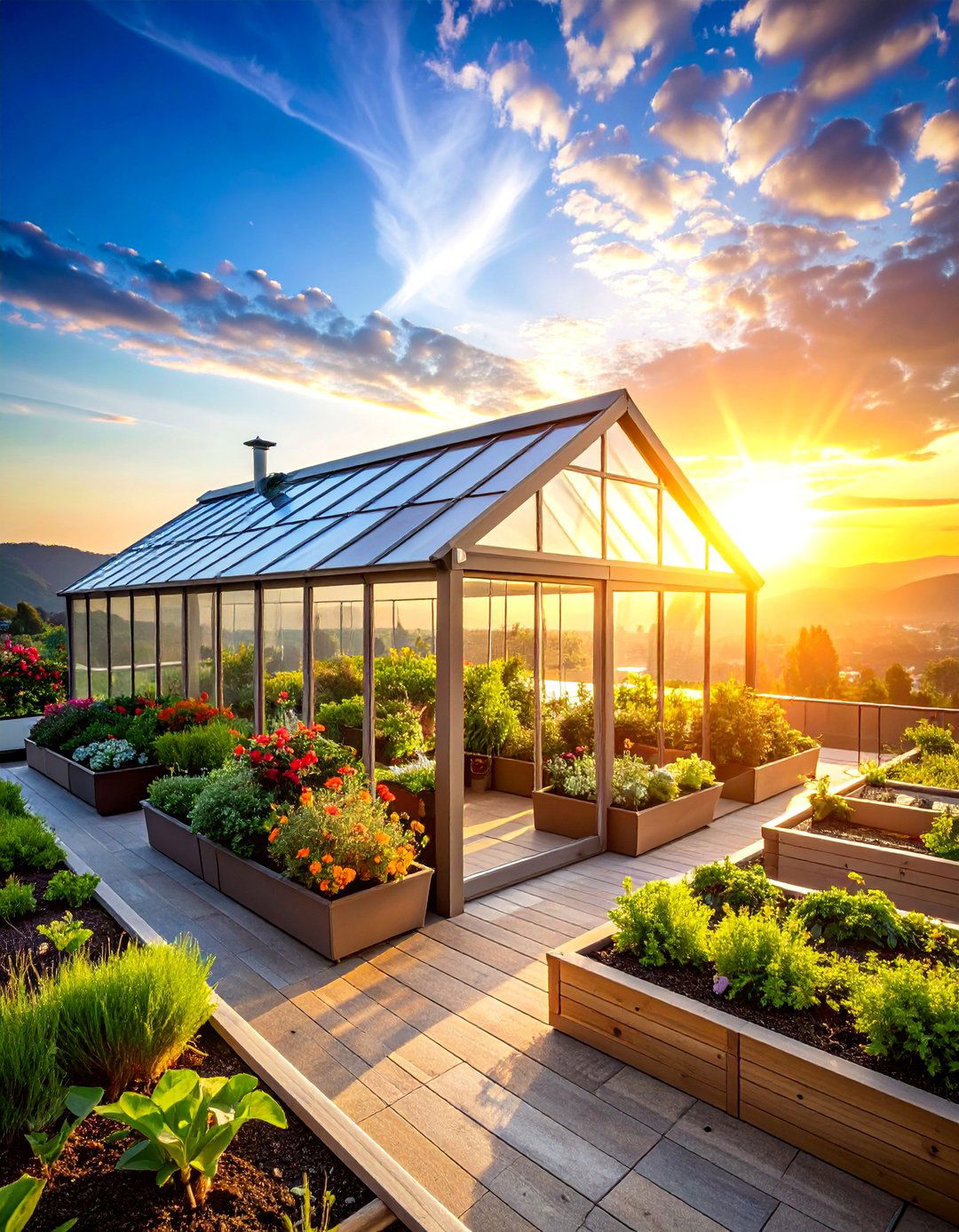
The slant-roof solar rooftop greenhouse maximizes southern exposure while incorporating thermal mass for natural climate regulation. This passive solar design features a steep south-facing slope with polycarbonate glazing and an insulated north wall that stores and releases heat throughout the day. Thermal mass elements include water barrels, concrete blocks, or phase-change materials that moderate temperature fluctuations. Automated ventilation systems use solar-powered fans and temperature-sensitive vents to maintain optimal growing conditions. The interior layout includes raised beds with built-in irrigation and vertical growing systems that maximize production space. This greenhouse design excels in cold climates where season extension is crucial for vegetable production. The energy-efficient design reduces heating costs while providing a comfortable environment for both plants and gardeners during winter months, making it perfect for year-round food production in northern regions.
6. Multi-Zone Climate Controlled Rooftop Greenhouse

The multi-zone climate controlled rooftop greenhouse creates distinct growing environments within a single structure for diverse crop production. This sophisticated design features separate compartments with independent climate control systems, allowing cultivation of tropical, temperate, and cool-season crops simultaneously. Advanced environmental controls include zone-specific heating, cooling, humidity, and lighting systems managed through centralized automation. Each zone features specialized growing systems such as deep water culture for leafy greens, media beds for fruiting plants, and misting systems for propagation areas. The structure incorporates moveable partitions that allow seasonal reconfiguration based on crop rotation schedules. This design is ideal for research institutions, botanical gardens, and commercial growers who need maximum flexibility and production diversity. The system enables year-round cultivation of high-value specialty crops while optimizing resource utilization and minimizing energy consumption through zone-based management.
7. Vertical Aeroponic Tower Rooftop Greenhouse

The vertical aeroponic tower rooftop greenhouse maximizes production density through innovative growing tower systems that deliver nutrients directly to plant roots through misting. This space-efficient design features rotating or stationary towers that support multiple growing levels, dramatically increasing yield per square foot. Advanced aeroponic systems provide precise nutrient delivery while using minimal water and growing medium. Climate control includes LED lighting systems, automated ventilation, and humidity management optimized for vertical growing. The structure utilizes lightweight materials and wind-resistant design to accommodate the unique load requirements of tower systems. Automated harvesting and maintenance systems reduce labor requirements while ensuring consistent crop quality. This greenhouse design is perfect for urban areas with limited roof space but high demand for fresh produce, offering the potential to produce leafy greens, herbs, and strawberries with yields significantly higher than traditional growing methods.
8. Geodesic Dome Thermal Mass Rooftop Greenhouse

The geodesic dome thermal mass rooftop greenhouse combines innovative architecture with passive solar design for energy-efficient year-round growing. This unique structure features triangular polycarbonate panels arranged in a geodesic pattern that provides exceptional strength and wind resistance. The design incorporates substantial thermal mass through an underground thermal battery or central water feature that stores solar energy during the day and releases it at night. Natural ventilation systems use the dome's geometry to create efficient air circulation patterns. The circular layout maximizes growing space while minimizing materials and construction costs. Solar panels integrated into select dome panels provide renewable energy for circulation fans and monitoring systems. This greenhouse design offers superior performance in extreme weather conditions while creating a unique architectural feature that serves as both functional growing space and educational demonstration of sustainable building technologies and permaculture principles.
9. Retractable Roof Hybrid Rooftop Greenhouse

The retractable roof hybrid rooftop greenhouse provides the flexibility of both protected and open-air growing through automated roof panels that open during favorable weather. This innovative design features motorized roof sections that retract to provide natural rainfall, increased ventilation, and direct sunlight exposure when conditions are optimal. Advanced weather monitoring systems automatically close the roof during storms, extreme temperatures, or high winds. The structure includes both soil-based raised beds and hydroponic systems to accommodate different growing preferences and crop types. Climate control systems provide backup environmental management when the roof is closed, ensuring consistent growing conditions. This design is ideal for regions with mild climates where outdoor growing is possible for extended periods but protection is needed during specific seasons. The flexibility allows for transitional growing that combines the benefits of greenhouse protection with natural outdoor conditions.
10. Smart Glass Technology Rooftop Greenhouse

The smart glass technology rooftop greenhouse features electrochromic glazing that automatically adjusts transparency based on light conditions and temperature requirements. This high-tech design uses smart glass panels that can switch from clear to opaque, providing dynamic shading and privacy control throughout the day. Advanced sensors monitor internal conditions and automatically adjust glass opacity to maintain optimal growing environments. The system includes integrated LED lighting that supplements natural light during low-light periods or when glass is dimmed. Climate control systems work in conjunction with smart glass to optimize energy efficiency and plant health. This greenhouse design represents the cutting edge of greenhouse technology, offering precise environmental control while minimizing energy consumption. The smart glass system reduces the need for mechanical shading systems while providing superior climate management, making it ideal for high-value crop production and research applications requiring precise environmental conditions.
11. Community-Accessible Educational Rooftop Greenhouse
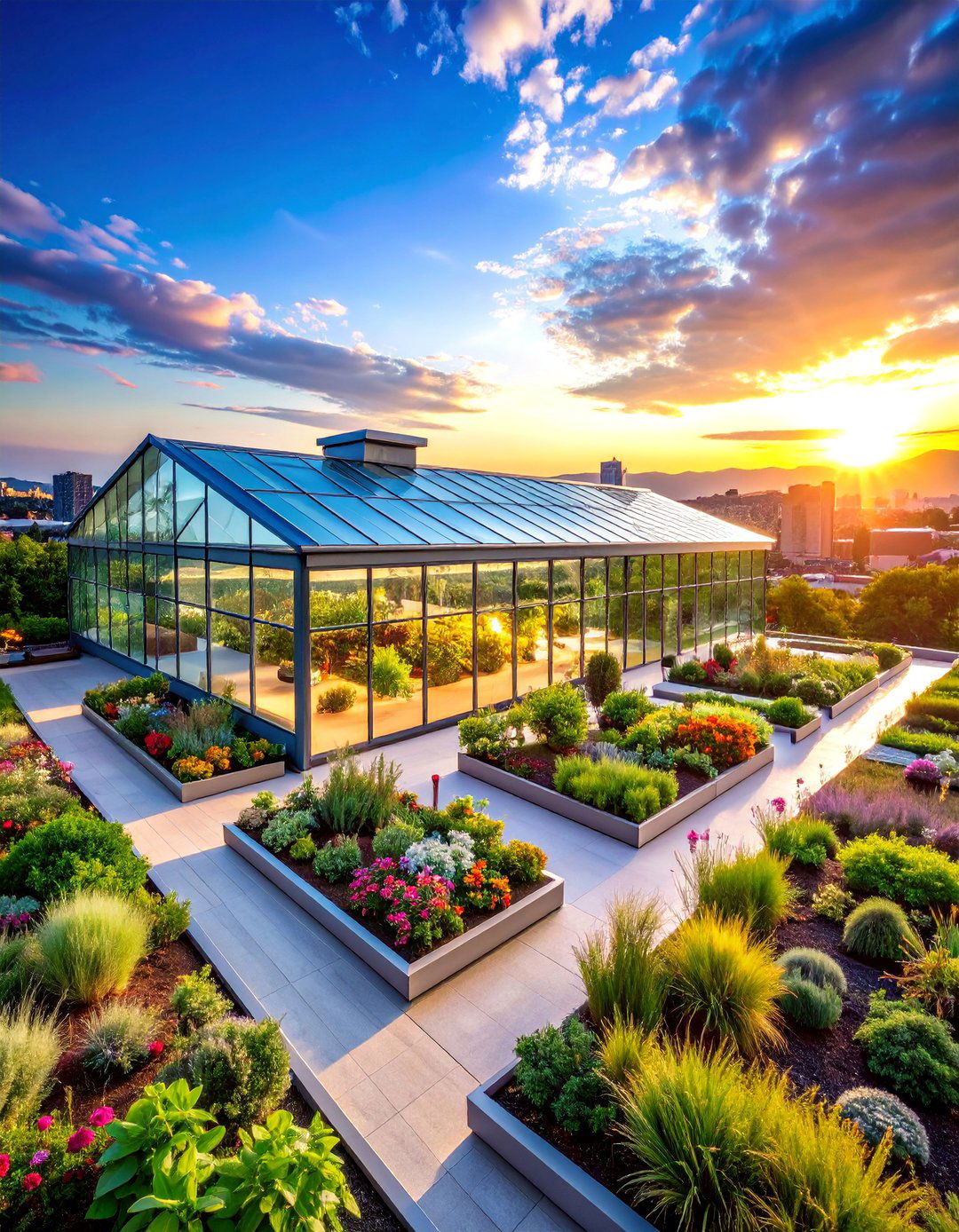
The community-accessible educational rooftop greenhouse serves as both productive growing space and learning center for urban agriculture education. This inclusive design features wide pathways, accessible raised beds, and demonstration areas that accommodate visitors of all ages and abilities. The structure includes classroom space, tool storage, and processing areas for hands-on learning experiences. Growing systems showcase various techniques including hydroponics, aquaponics, composting, and organic soil cultivation. Interactive displays and monitoring systems allow visitors to learn about plant biology, environmental science, and sustainable agriculture practices. The design incorporates safety features including non-slip flooring, protective barriers, and emergency access routes. This greenhouse serves schools, community centers, and urban agriculture organizations by providing practical education opportunities while producing fresh food for local consumption. The design emphasizes transparency and engagement, encouraging community participation in sustainable food production and environmental stewardship.
12. Wind-Resistant Steel Frame Rooftop Greenhouse

The wind-resistant steel frame rooftop greenhouse provides exceptional durability for exposed rooftop locations subject to high winds and severe weather. This robust design features galvanized steel construction with engineered connections and anchor systems designed to withstand extreme wind loads. The structure utilizes impact-resistant polycarbonate glazing and reinforced door systems that maintain integrity during storms. Aerodynamic design elements minimize wind resistance while providing adequate ventilation and light transmission. Foundation systems include deep anchoring and load distribution to protect building integrity. Growing systems are secured and designed to function during adverse weather conditions. Emergency systems include backup power, communication, and shelter areas for operator safety. This greenhouse design is essential for coastal areas, tall buildings, or regions prone to severe weather where standard structures would fail. The investment in superior construction ensures continuous operation and crop protection regardless of weather conditions, making it suitable for commercial operations requiring reliable production.
13. Rainwater Harvesting Integrated Rooftop Greenhouse
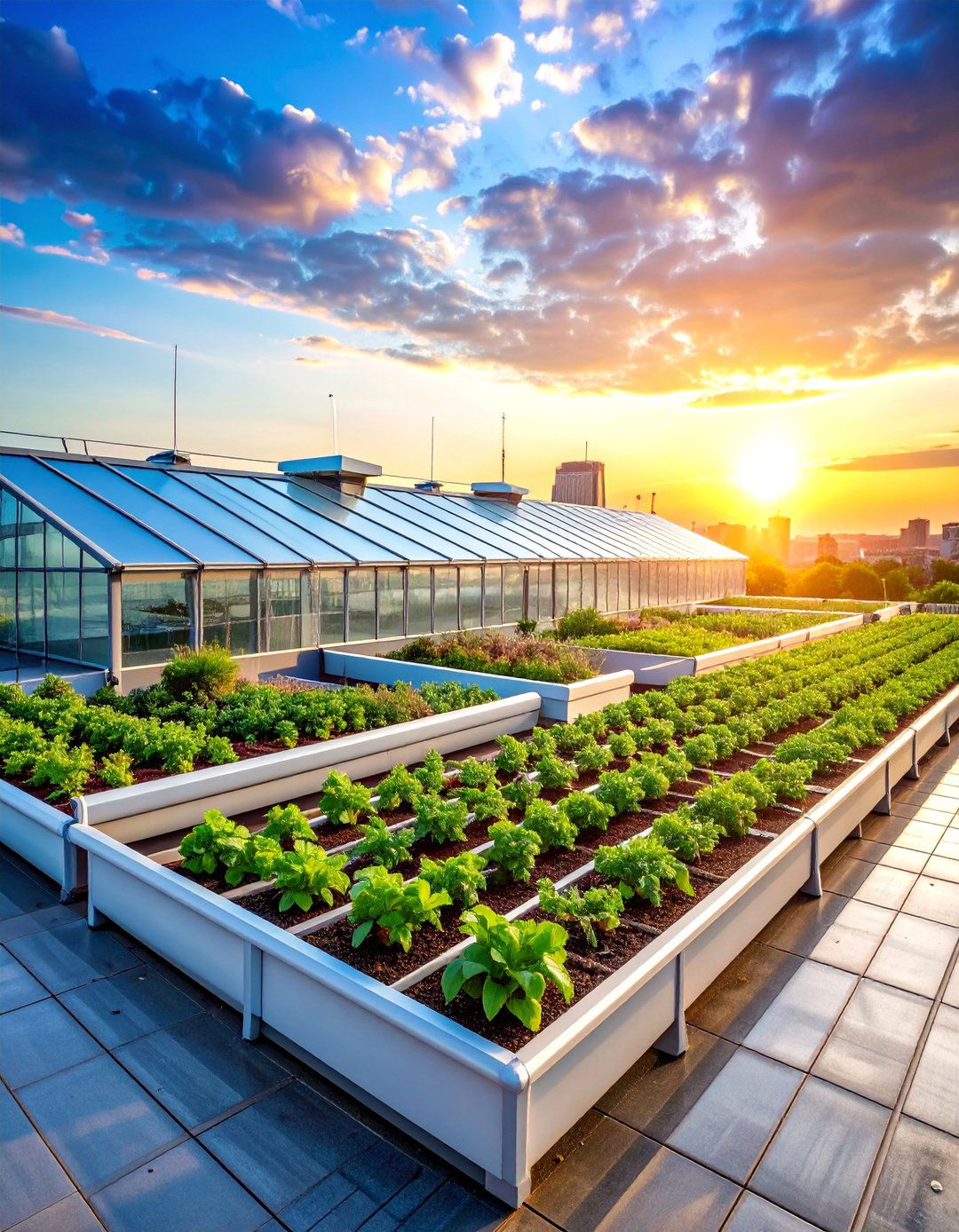
The rainwater harvesting integrated rooftop greenhouse maximizes water conservation through comprehensive collection, treatment, and reuse systems. This sustainable design features gutters, downspouts, and storage tanks that capture and store rainwater for irrigation and cooling systems. Advanced filtration systems including sediment filters, carbon filtration, and UV sterilization ensure water quality for plant production. The structure incorporates green roof elements that help filter runoff while providing additional growing space. Automated irrigation systems optimize water usage through soil moisture monitoring and weather-based scheduling. Overflow management systems direct excess water to building drainage or secondary storage. This design reduces municipal water consumption by up to eighty percent while providing superior water quality for sensitive crops. The integrated approach combines water conservation with food production, making it ideal for buildings seeking sustainability certifications or regions with water restrictions or high utility costs.
14. Year-Round Heated Greenhouse with Thermal Storage
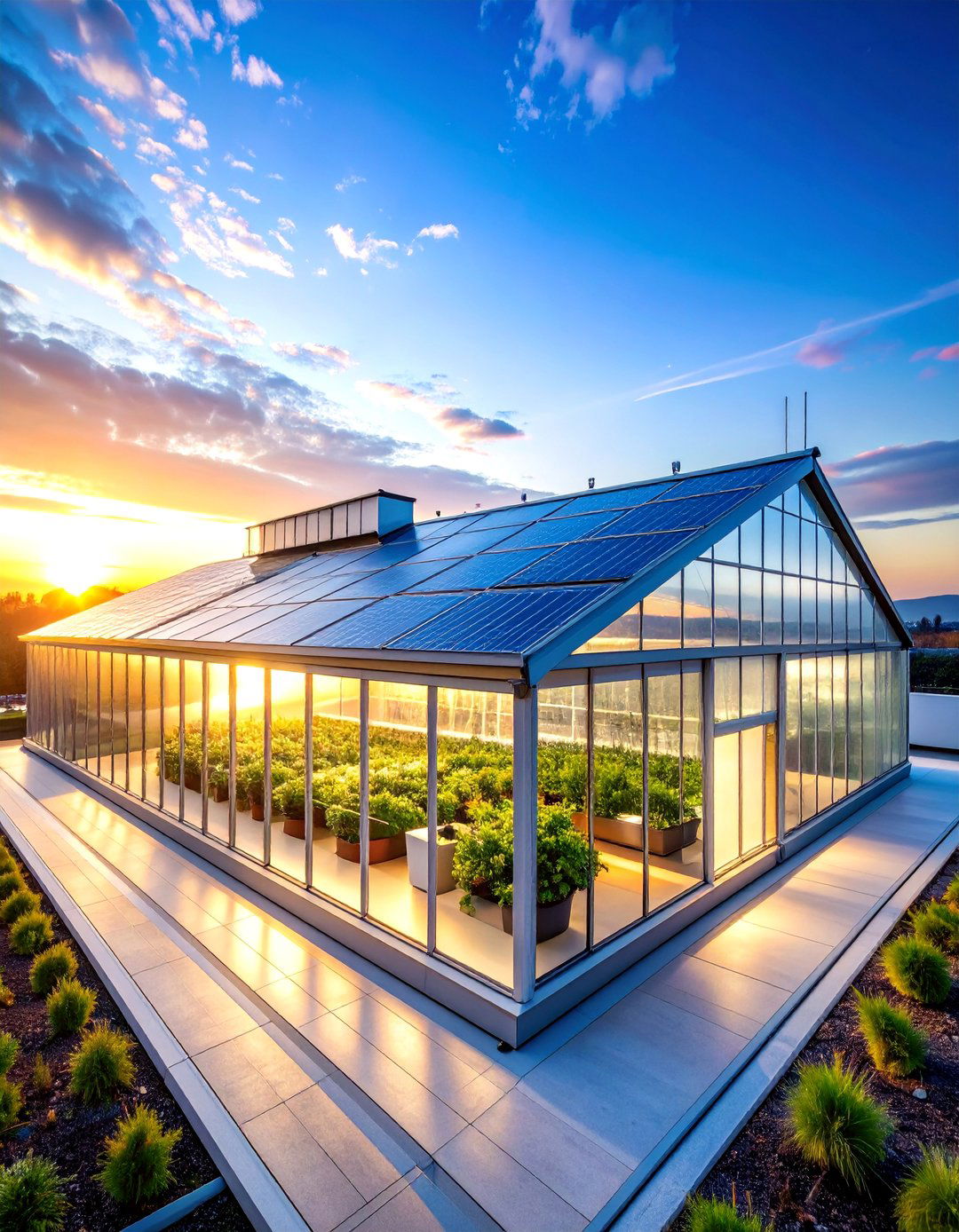
The year-round heated greenhouse with thermal storage maintains optimal growing temperatures during cold months through innovative heat storage and distribution systems. This climate-controlled design features insulated walls, triple-glazed windows, and radiant heating systems that provide consistent warmth. Underground thermal batteries or phase-change materials store excess solar energy during warm periods and release it during cold nights. Backup heating systems include biomass boilers, geothermal systems, or efficient heat pumps that activate during extended cold periods. The structure incorporates thermal curtains and automatic ventilation to prevent overheating during sunny winter days. Growing systems include heated propagation areas, temperature-controlled growing zones, and cold-hardy crop sections. This greenhouse design enables tropical and warm-season crop production year-round in cold climates, extending growing seasons and improving food security. The thermal storage systems reduce energy costs while maintaining precise environmental control for high-value crop production.
15. Modular Expandable Rooftop Greenhouse System
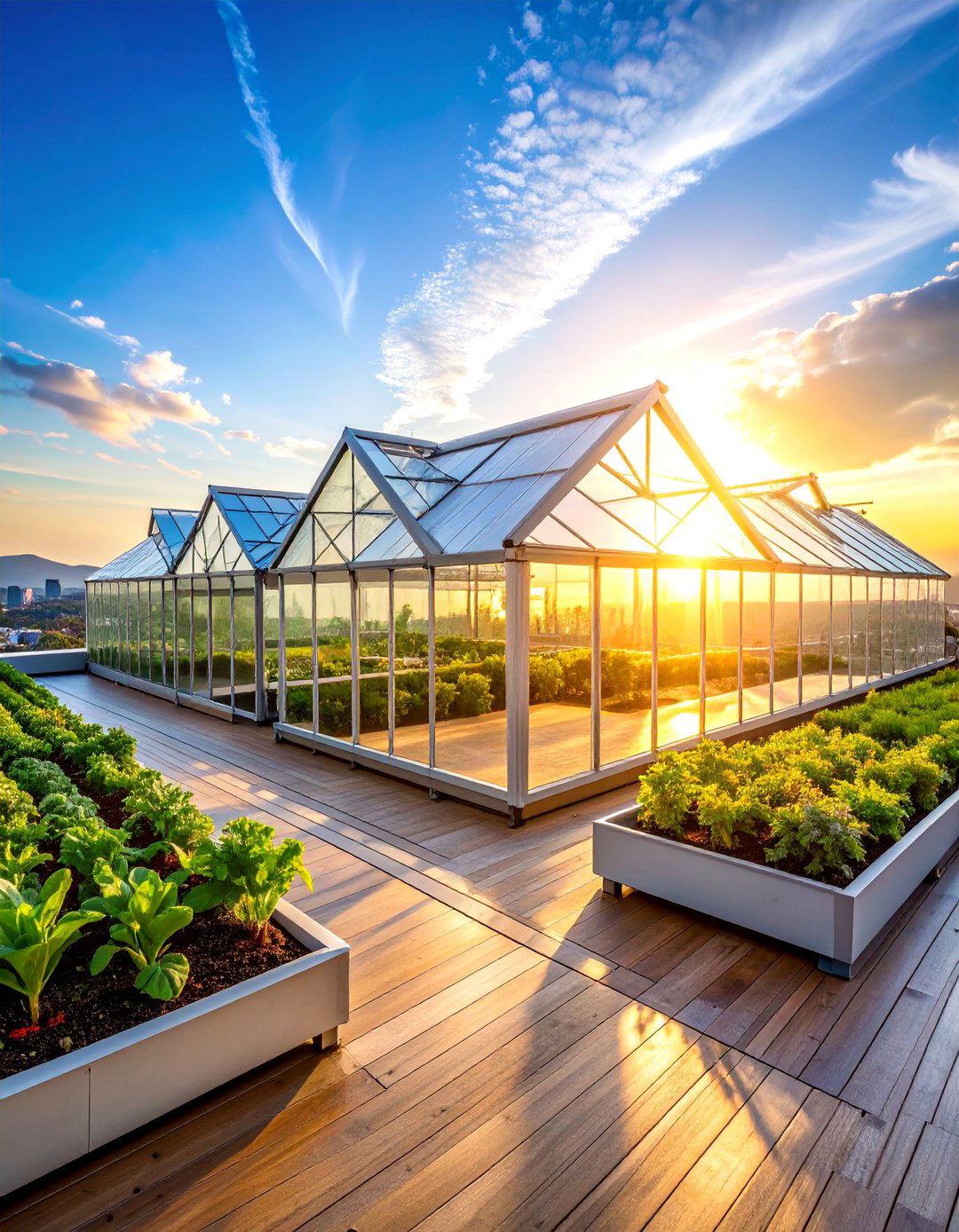
The modular expandable rooftop greenhouse system provides scalable growing capacity through interconnected units that can be added or reconfigured as needs change. This flexible design features standardized components including frame sections, glazing panels, and connection hardware that allow easy expansion. Each module includes independent growing systems, climate control, and utilities that function independently or as integrated systems. Modular designs accommodate different roof configurations, load requirements, and access limitations common in urban environments. Growing systems can be specialized within each module for different crop types or production methods. The system includes shared resources such as tool storage, processing areas, and common walkways between modules. This design is perfect for businesses, institutions, or communities that need to start small and expand gradually. The modular approach reduces initial investment while providing flexibility for changing needs and allows for efficient maintenance and system upgrades over time.
16. Bioshelter Integrated Living System Rooftop Greenhouse

The bioshelter integrated living system rooftop greenhouse creates a complete ecosystem that integrates food production, waste processing, and renewable energy generation. This holistic design features aquaponics systems, composting areas, and renewable energy components that work together as a closed-loop system. The structure includes areas for food production, waste processing, energy generation, and human activity spaces. Living systems include beneficial insects, soil microorganisms, and diverse plant communities that create natural pest control and nutrient cycling. Water features provide thermal mass, humidity control, and aquaculture production while supporting ecosystem functions. The design incorporates natural building materials, passive solar heating, and biological waste treatment systems. This greenhouse represents the pinnacle of sustainable design, creating a regenerative system that produces food, energy, and fertile soil while processing organic waste. The bioshelter concept is ideal for eco-villages, sustainable communities, and educational institutions demonstrating ecological design principles.
17. Passive Solar Underground Thermal Battery Rooftop Greenhouse

The passive solar underground thermal battery rooftop greenhouse utilizes underground air circulation systems to moderate temperature fluctuations throughout the year. This energy-efficient design features buried perforated pipes that circulate air through stable underground temperatures to heat or cool the greenhouse naturally. The system includes solar-powered fans that draw air through underground loops and distribute it throughout the growing space. Thermal mass elements including water features, masonry walls, and rock beds store and release energy to maintain consistent temperatures. The structure incorporates south-facing glazing, insulated north walls, and thermal curtains for optimal passive solar performance. Growing systems take advantage of stable soil temperatures through underground root zones and thermal regulation. This design dramatically reduces heating and cooling costs while providing superior environmental control. The underground thermal battery system is particularly effective in climates with extreme temperature variations, offering year-round growing capability with minimal energy input.
18. Living Machine Waste Processing Rooftop Greenhouse
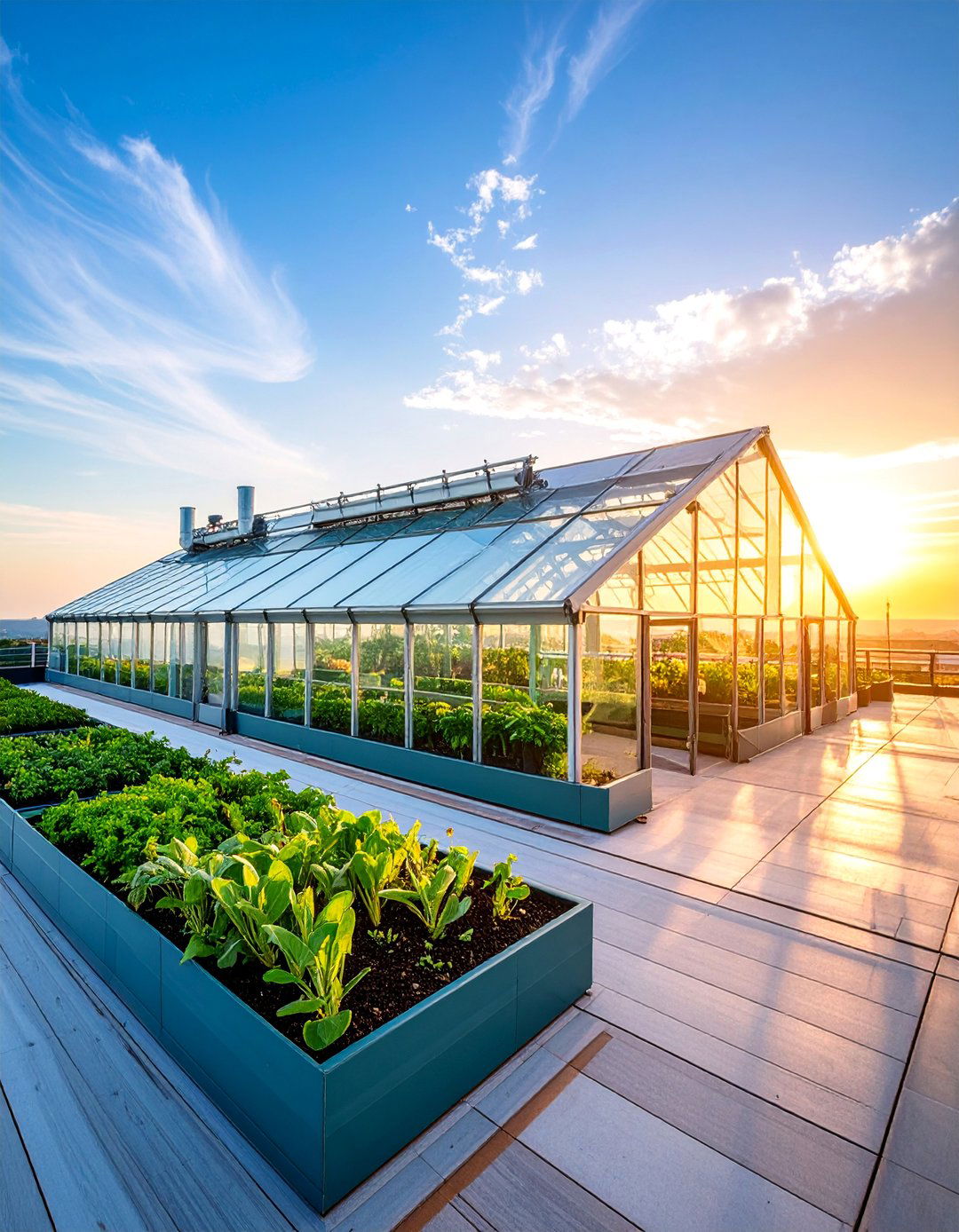
The living machine waste processing rooftop greenhouse combines food production with biological wastewater treatment using natural systems to process building waste streams. This innovative design features constructed wetlands, biofilters, and living machines that treat greywater and blackwater while producing clean water for irrigation. The system includes sequential treatment stages with different plant communities that remove contaminants and nutrients from wastewater. Growing areas utilize treated water and recovered nutrients for food production while completing the nutrient cycle. The structure incorporates odor control, safety systems, and monitoring equipment to ensure proper operation and health protection. Educational components demonstrate natural waste processing and resource recovery principles. This greenhouse design provides both waste treatment and food production services, reducing building utility costs while producing fresh food. The living machine approach is ideal for eco-buildings, research facilities, and communities seeking to close resource loops and demonstrate sustainable waste management practices.
19. Hydroponic Vertical Farm Production Rooftop Greenhouse

The hydroponic vertical farm production rooftop greenhouse maximizes crop density through multi-level growing systems designed for commercial-scale urban agriculture. This intensive design features stacked growing trays, automated seeding systems, and robotic harvesting equipment that enable high-volume production in limited space. Advanced LED lighting systems provide optimal spectrum and intensity for each crop type and growth stage. Climate control systems maintain precise temperature, humidity, and air circulation throughout multiple growing levels. Automated nutrient delivery systems monitor and adjust growing conditions for each level independently. The structure includes processing areas, packaging facilities, and cold storage for complete production operations. This greenhouse design can produce leafy greens, herbs, and microgreens equivalent to several acres of traditional farming in a compact footprint. The vertical farm approach is ideal for urban areas where land costs are high and fresh produce demand is strong, offering year-round production with minimal environmental impact.
20. Solar Chimney Natural Ventilation Rooftop Greenhouse
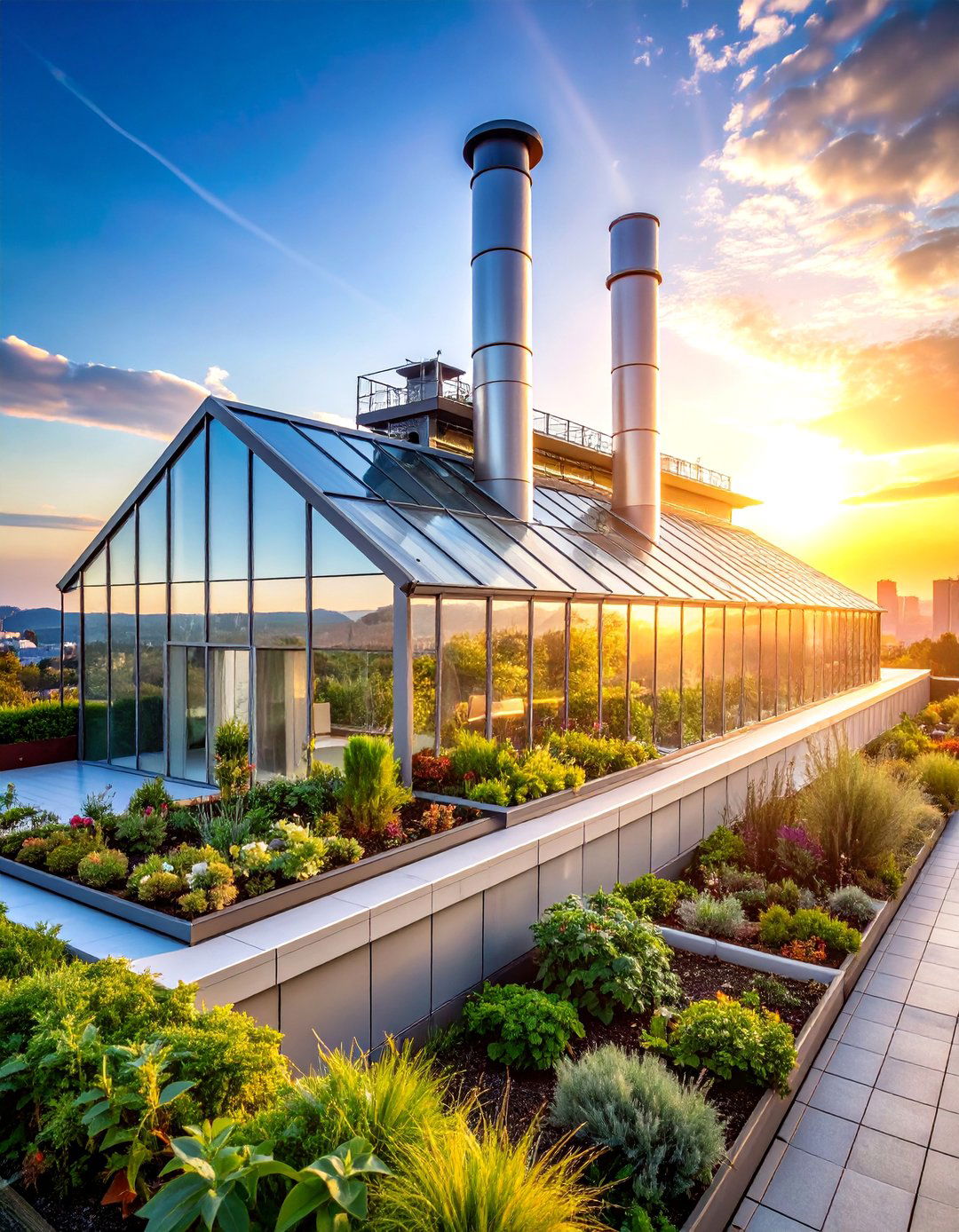
The solar chimney natural ventilation rooftop greenhouse uses passive air circulation to maintain optimal growing conditions without mechanical ventilation systems. This energy-efficient design features a tall central chimney that creates natural airflow through solar heating and thermal buoyancy effects. The structure includes strategically placed intake vents, circulation pathways, and exhaust openings that work together to provide continuous air exchange. Thermal mass elements help regulate air temperature while automated vent controls adjust airflow based on weather conditions. The design incorporates shade systems and evaporative cooling to enhance natural temperature control during hot weather. Growing systems take advantage of natural air circulation for pest management and plant health. This greenhouse design eliminates ventilation energy costs while providing superior air quality and climate control. The solar chimney system is particularly effective in hot climates where cooling is a major concern, offering sustainable environmental control through passive design principles rather than energy-intensive mechanical systems.
21. Aquaculture Integration Rooftop Greenhouse Complex
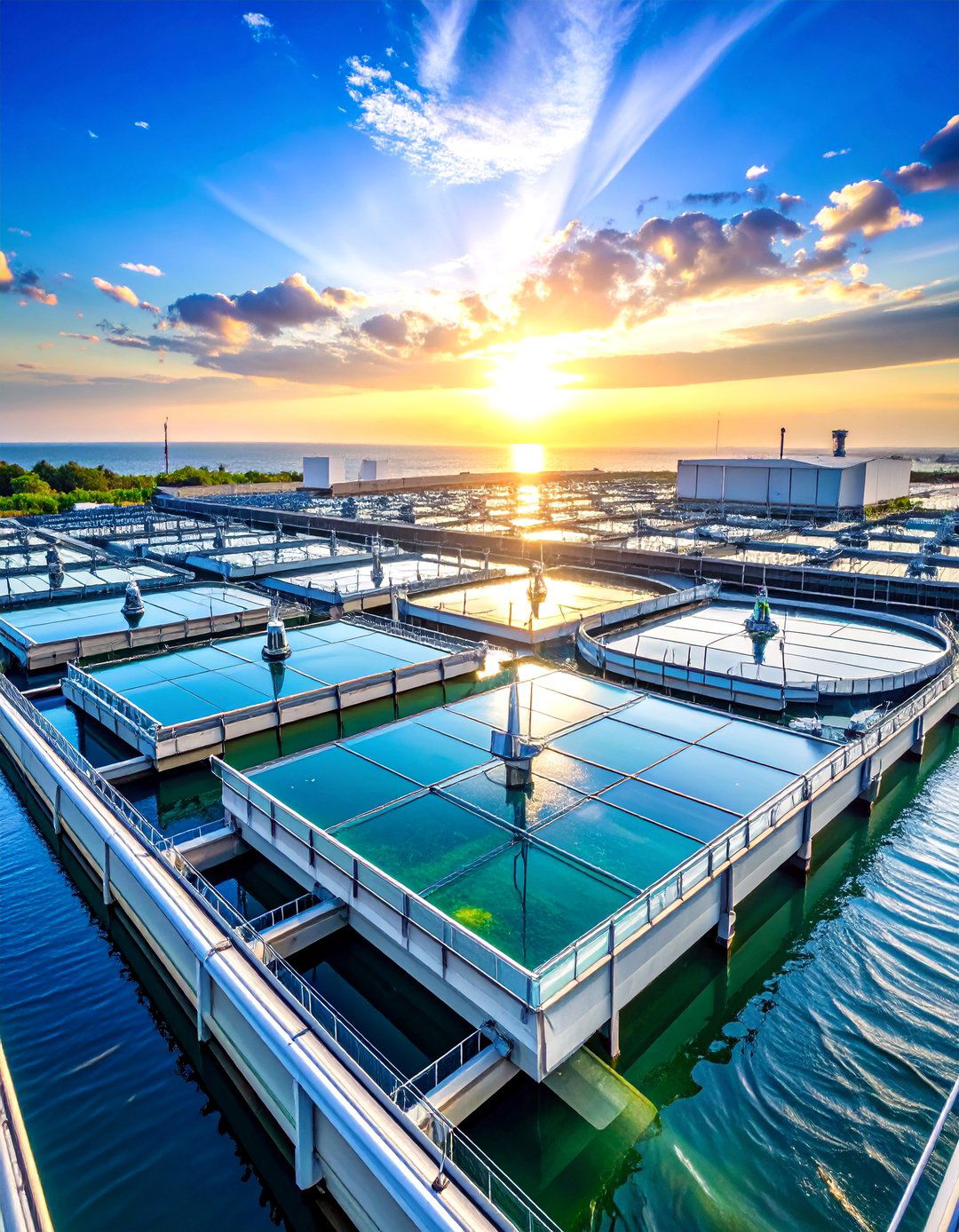
The aquaculture integration rooftop greenhouse complex combines fish farming with plant production in a comprehensive urban agriculture system. This design features insulated fish tanks, biofilter systems, and hydroponic growing beds that create beneficial relationships between aquatic and plant systems. The structure includes separate areas for fish breeding, growing, processing, and plant cultivation with shared water treatment and climate control systems. Advanced monitoring systems track water quality, fish health, and plant growth to optimize production in both systems. The design incorporates quarantine areas, disease prevention systems, and food safety protocols for both fish and plant products. Processing facilities enable value-added production including prepared foods and preserved products. This greenhouse complex provides complete protein and vegetable production in a single facility, offering exceptional nutritional diversity for urban food systems. The integrated approach maximizes resource efficiency while producing premium products for direct sales or institutional markets requiring locally-sourced, sustainably-produced food.
22. Research Laboratory Controlled Environment Rooftop Greenhouse
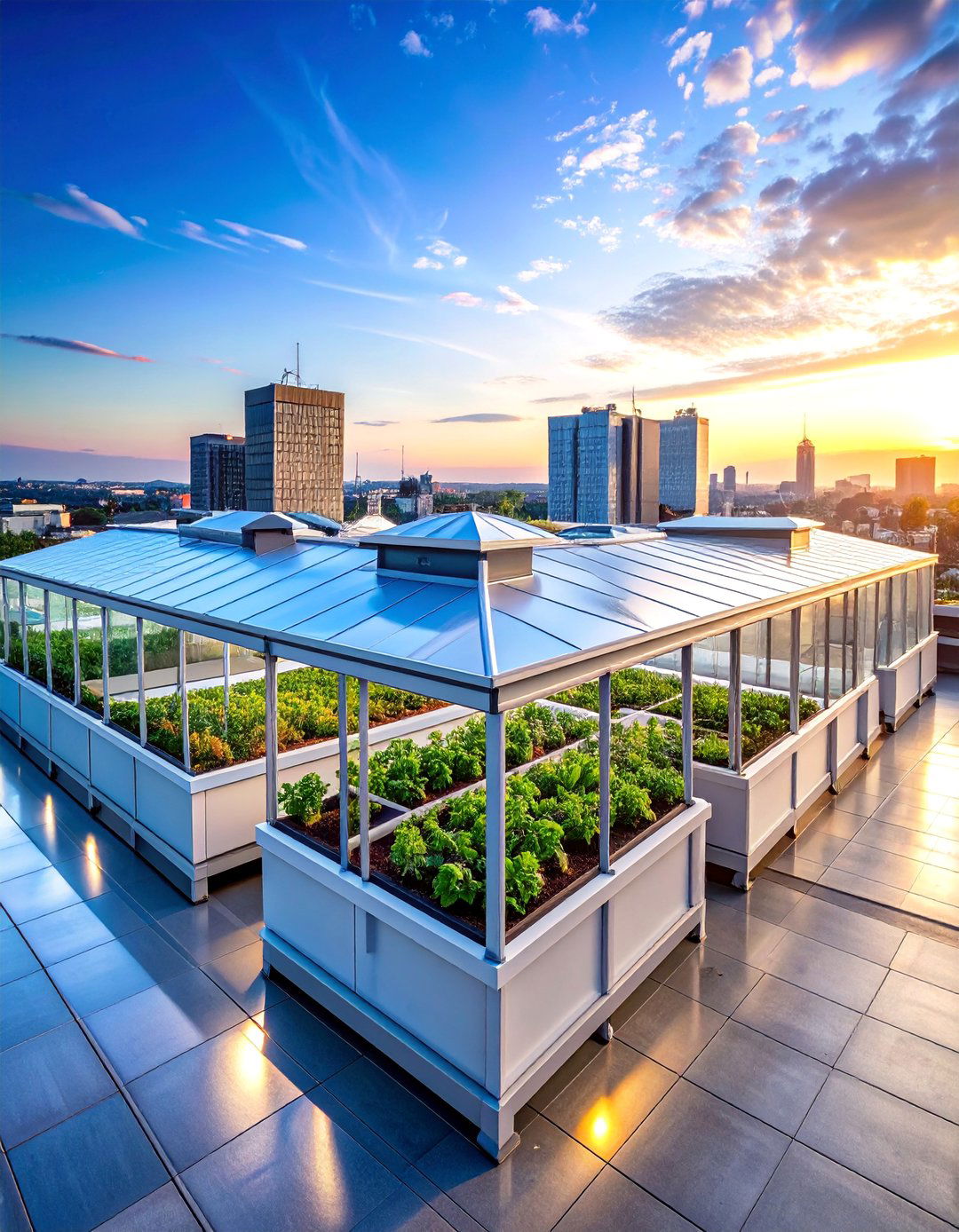
The research laboratory controlled environment rooftop greenhouse provides precise environmental control for agricultural research and plant breeding programs. This specialized design features multiple isolated growing chambers with independent climate control, lighting, and atmospheric management systems. Advanced monitoring equipment includes environmental sensors, gas analyzers, and automated data collection systems that support scientific research protocols. The structure incorporates clean room standards, contamination control, and specialized access procedures for research activities. Growing systems can be configured for different research needs including plant breeding, pest management studies, and environmental stress testing. Laboratory facilities include preparation areas, analytical equipment, and data processing capabilities. This greenhouse design enables cutting-edge agricultural research in urban environments where traditional research facilities are unavailable. The controlled environment capabilities support development of new crop varieties, growing techniques, and sustainable agriculture practices that can be transferred to commercial and community growing operations.
23. Cold Frame Extension Season Rooftop Greenhouse

The cold frame extension season rooftop greenhouse provides simple, cost-effective growing space for cool-season crops and season extension without complex systems. This minimalist design features low-profile construction with slanted glazing that captures maximum solar energy during cold months. The structure includes removable panels, adjustable ventilation, and thermal mass elements that provide frost protection and temperature moderation. Growing systems focus on cold-hardy crops including leafy greens, root vegetables, and herbs that thrive in cool conditions. The design incorporates row covers, thermal blankets, and protective systems for extreme weather conditions. Simple automation includes temperature-sensitive vent openers and basic monitoring systems. This greenhouse design offers excellent value for gardeners seeking to extend growing seasons without significant investment in complex infrastructure. The cold frame approach is ideal for residential applications, community gardens, and educational programs where simplicity and affordability are priorities while still providing effective season extension and crop protection.
24. Mobile Container Rooftop Greenhouse Unit

The mobile container rooftop greenhouse unit provides portable growing capacity through shipping container conversion with integrated growing systems and climate control. This innovative design features a complete growing facility within a standard shipping container that can be transported and installed on various rooftop locations. The unit includes hydroponic systems, LED lighting, climate control, and monitoring systems powered by solar panels and battery storage. Growing systems maximize space utilization through vertical arrangements and automated cultivation equipment. The container includes all necessary infrastructure including water storage, nutrient systems, and waste management. External connections provide utility hookups for buildings while maintaining operational independence. This greenhouse design offers flexibility for temporary installations, disaster response, and rapid deployment of urban agriculture capacity. The mobile approach enables agricultural production in areas lacking permanent growing infrastructure while providing opportunities for equipment testing and system demonstration across multiple locations and climate conditions.
25. Hybrid Solar Greenhouse Restaurant Production Facility
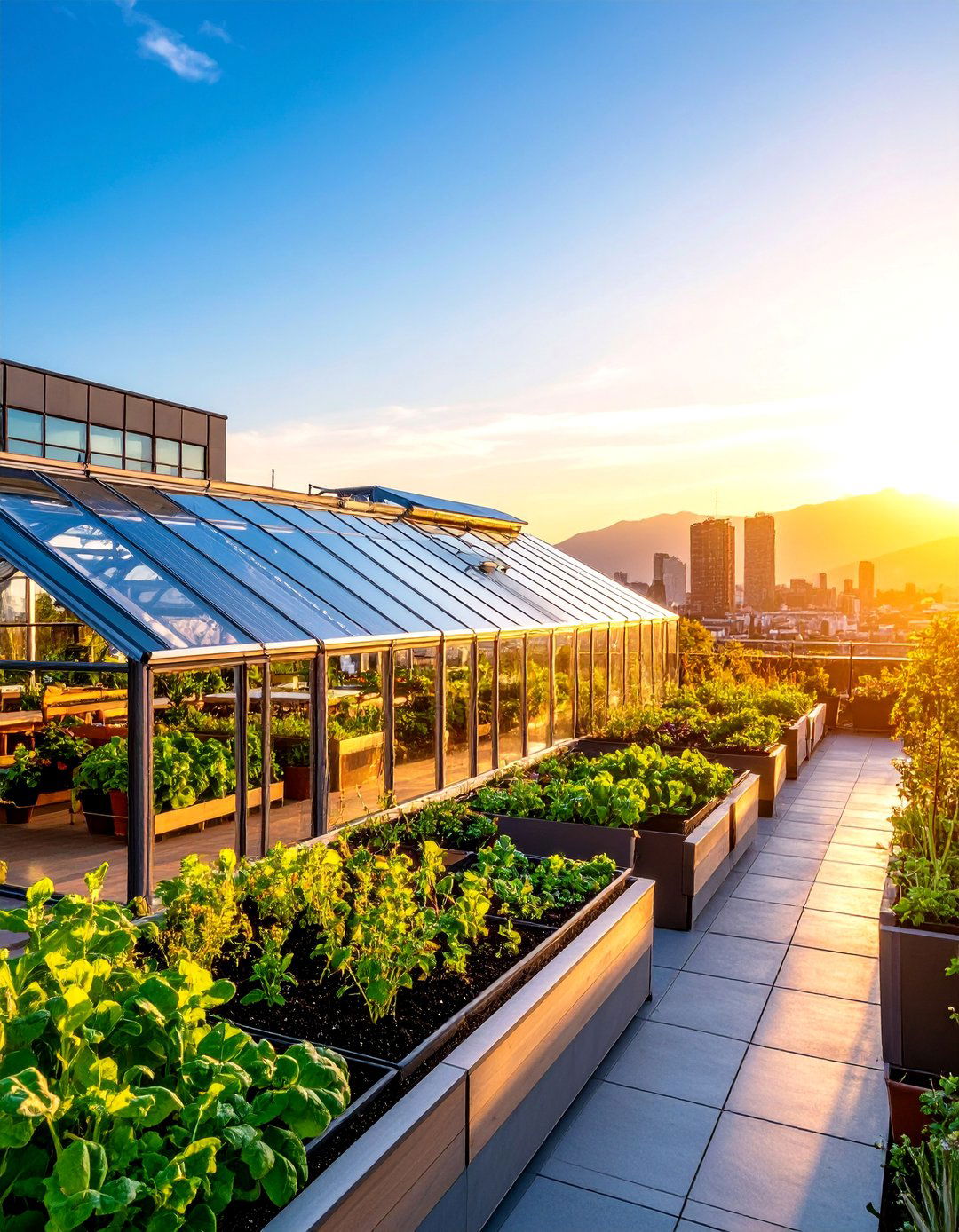
The hybrid solar greenhouse restaurant production facility integrates food production directly with dining establishments through on-site growing systems and farm-to-table operations. This comprehensive design features growing areas, harvesting facilities, and processing spaces that supply fresh ingredients directly to restaurant kitchens. The structure includes dining areas where customers can view growing operations while enjoying meals prepared with just-harvested ingredients. Advanced growing systems produce herbs, microgreens, leafy vegetables, and specialty crops that enhance menu offerings and reduce food costs. Climate control systems maintain optimal growing conditions while providing comfortable dining environments. The design incorporates educational elements including guided tours, cooking demonstrations, and hands-on growing experiences for restaurant patrons. Marketing features highlight sustainable practices, local food production, and reduced food miles to attract environmentally conscious customers. This greenhouse design creates unique dining experiences while demonstrating sustainable restaurant operations and urban agriculture integration that supports both business success and community education.
Conclusion:
Rooftop greenhouses represent transformative solutions for urban agriculture, combining innovative design with sustainable technology to create productive growing environments in unexpected spaces. These diverse approaches demonstrate how creativity and engineering can address food security, environmental challenges, and community needs simultaneously. From simple cold frames to sophisticated automated systems, each design offers unique benefits suited to different goals, budgets, and locations. The integration of renewable energy, water conservation, and climate control technologies makes these systems increasingly viable for urban food production. As cities continue to grow and climate challenges intensify, rooftop greenhouses will play an essential role in creating resilient, sustainable food systems that bring production closer to consumption while building stronger communities.




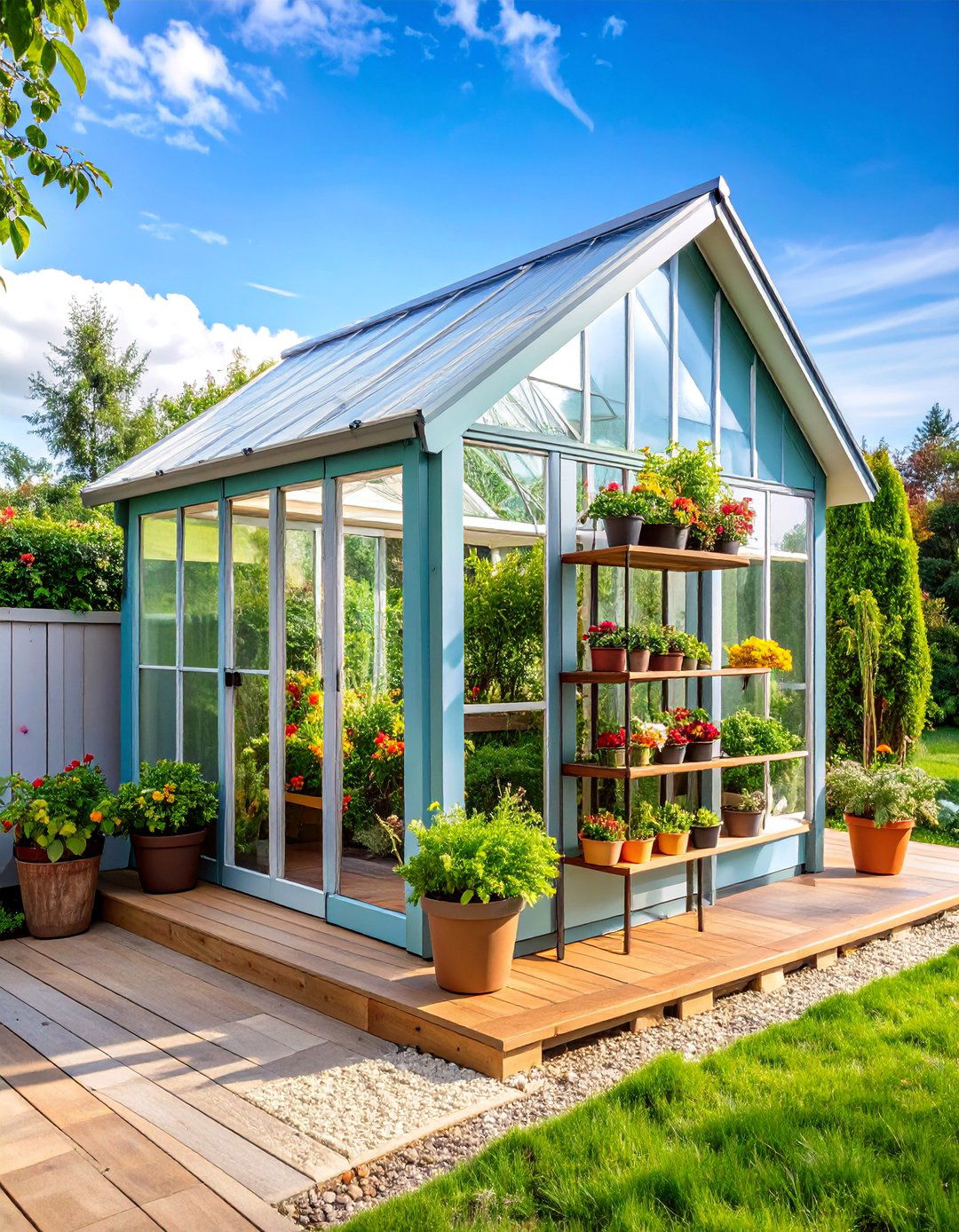
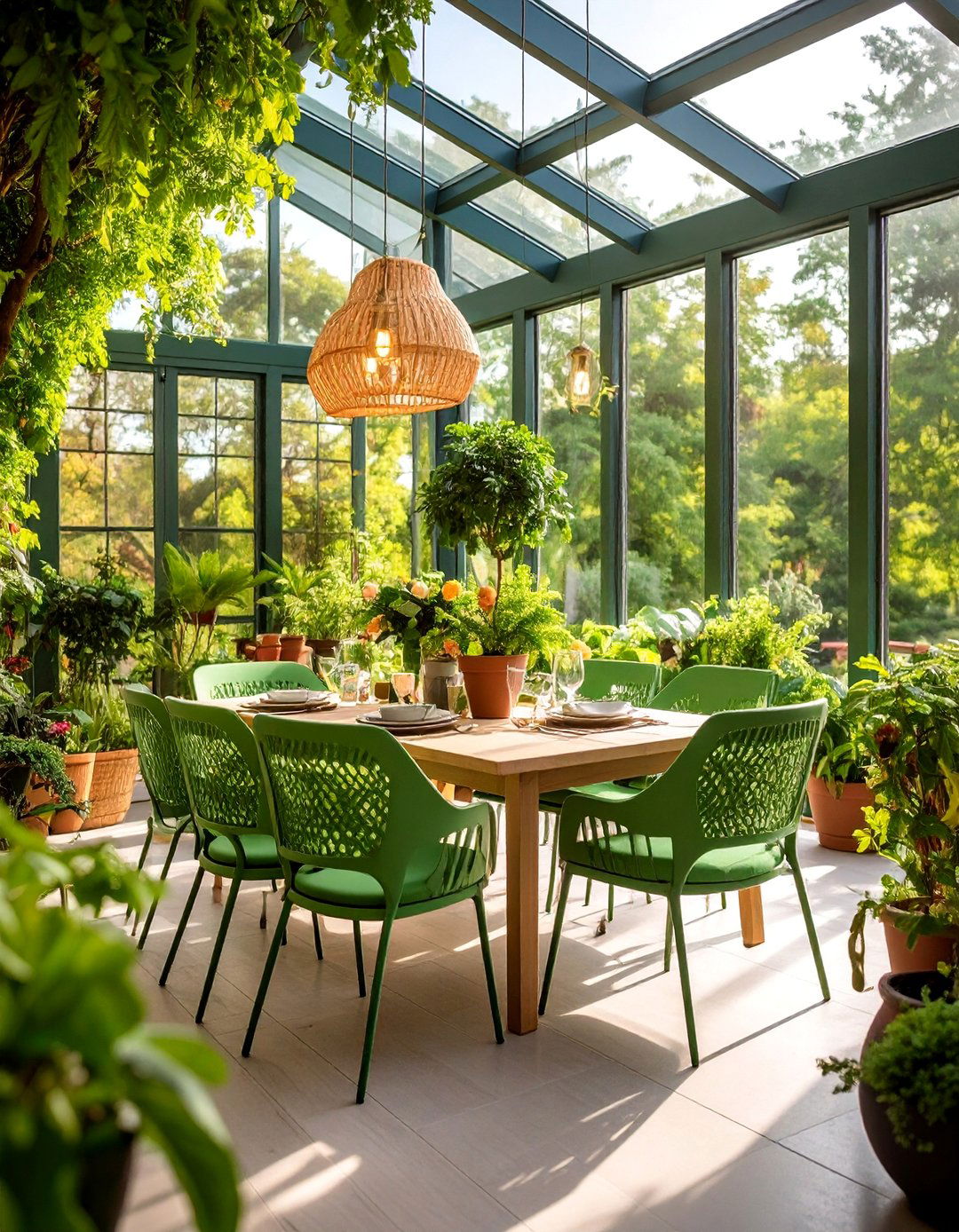


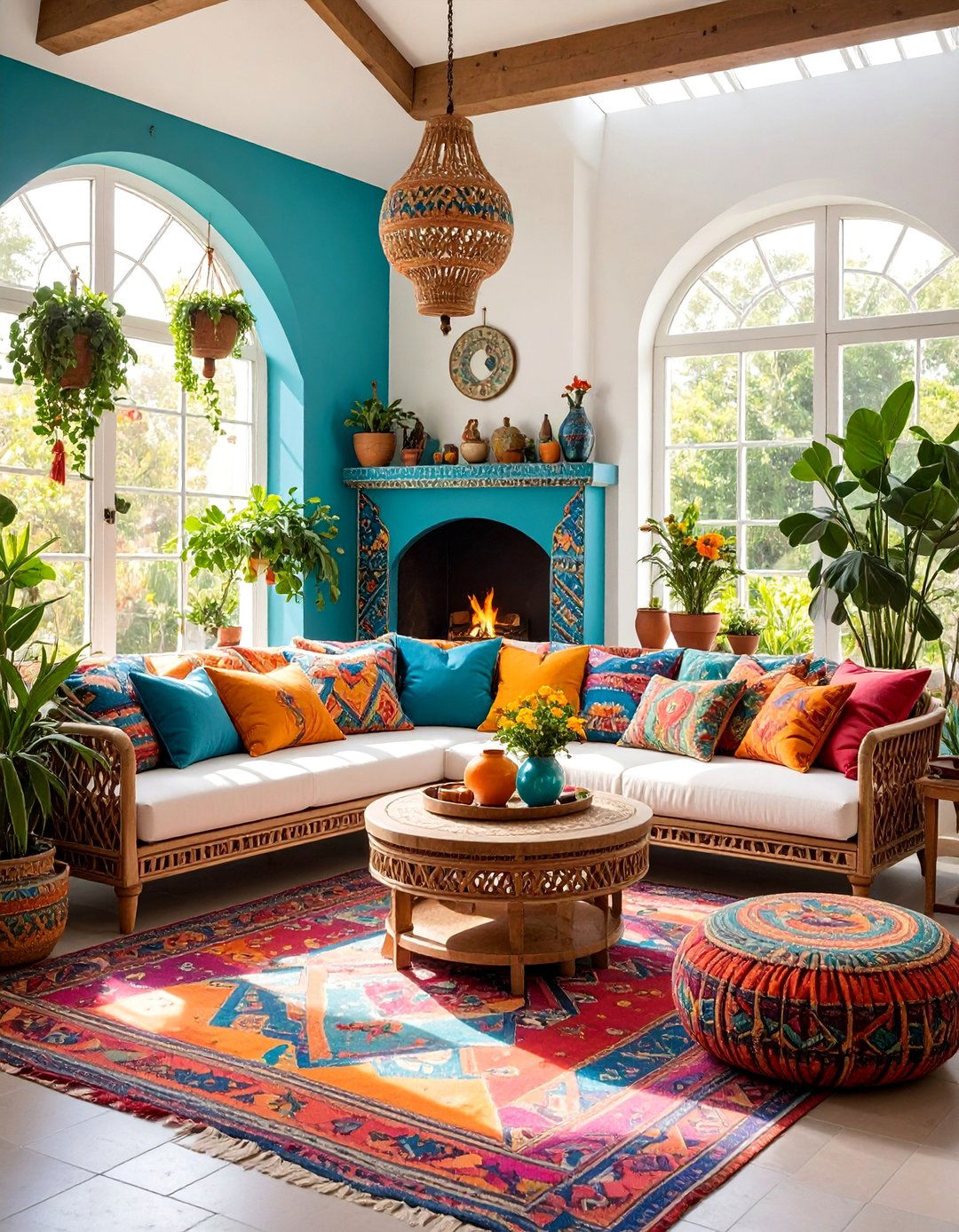





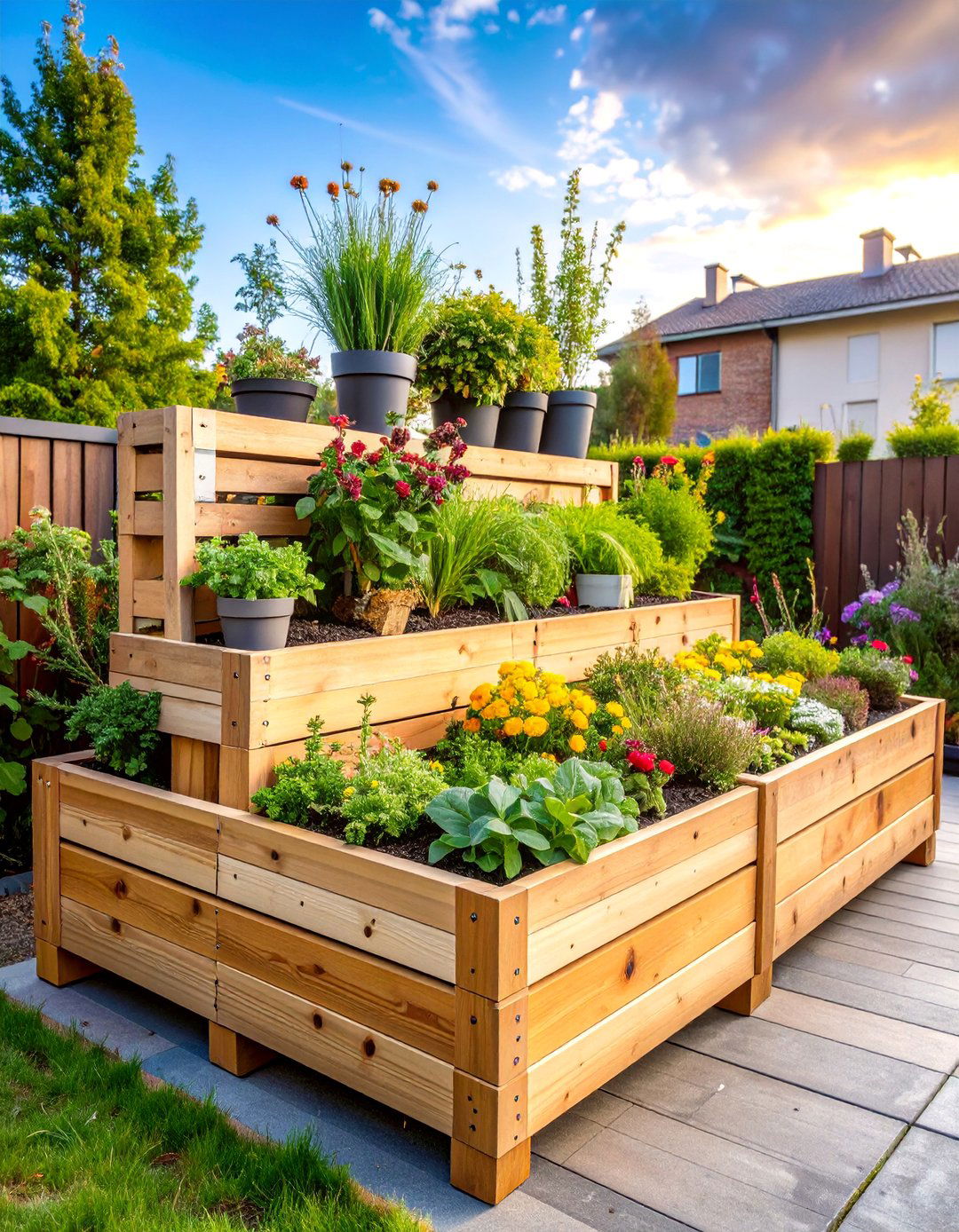
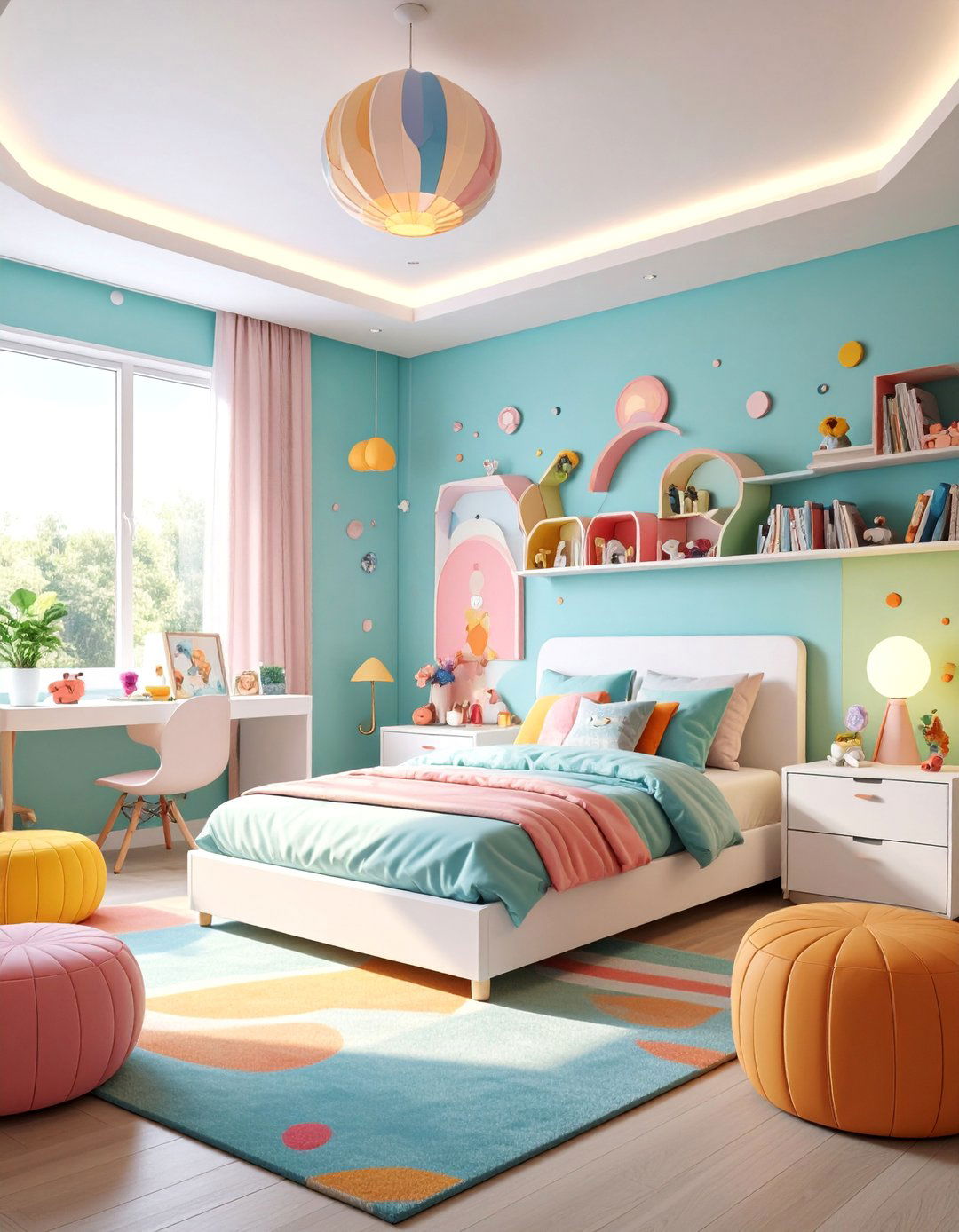
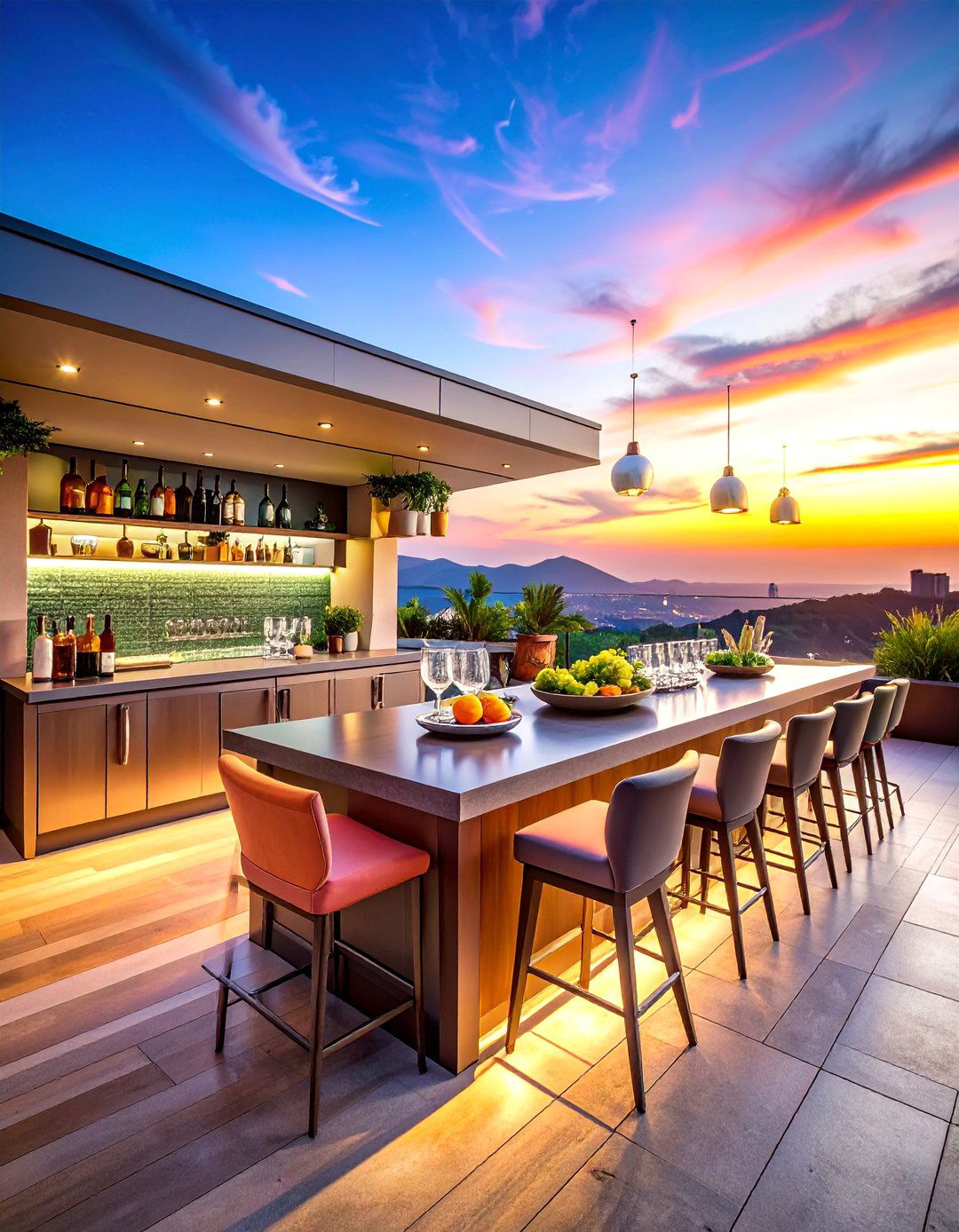
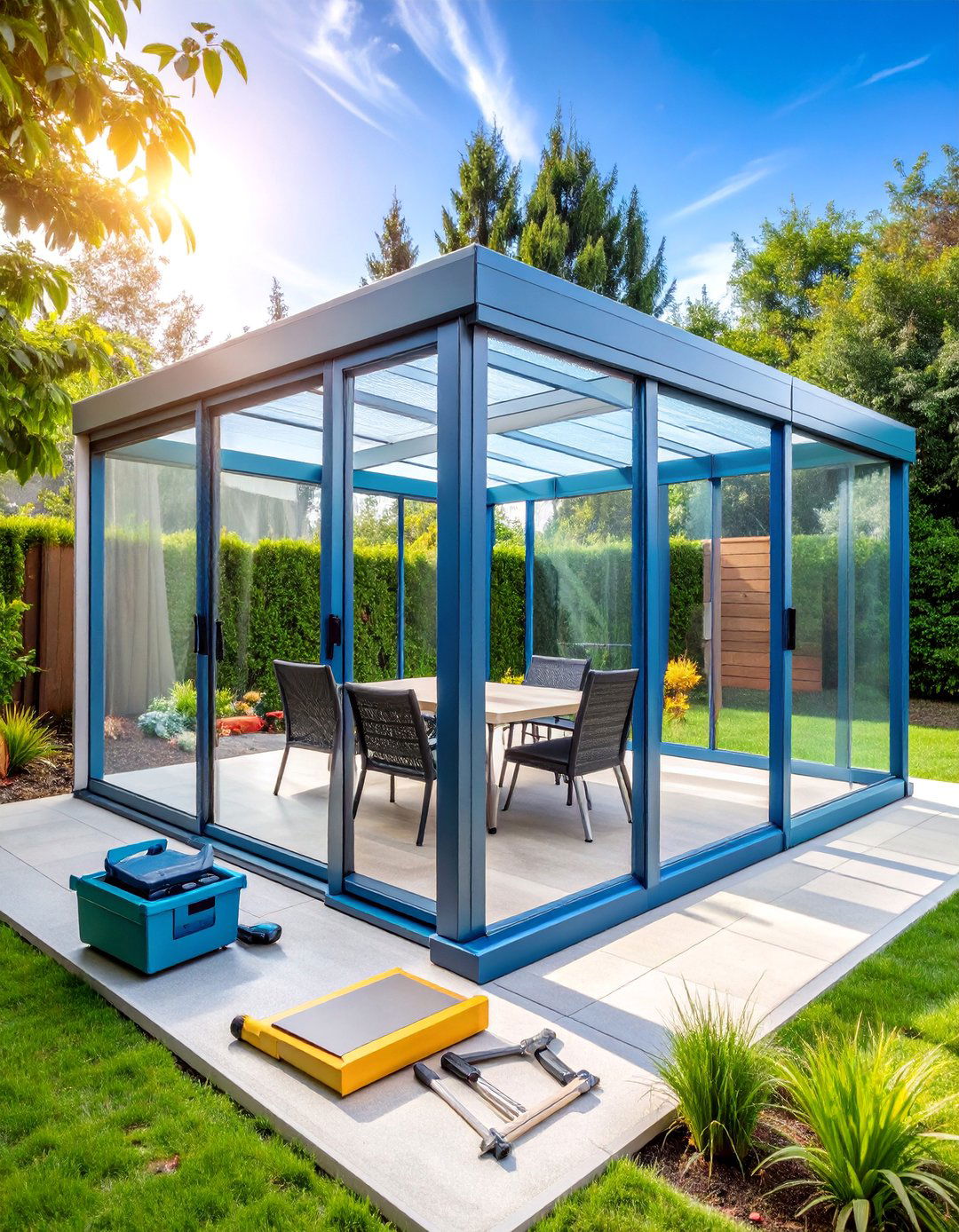
Leave a Reply